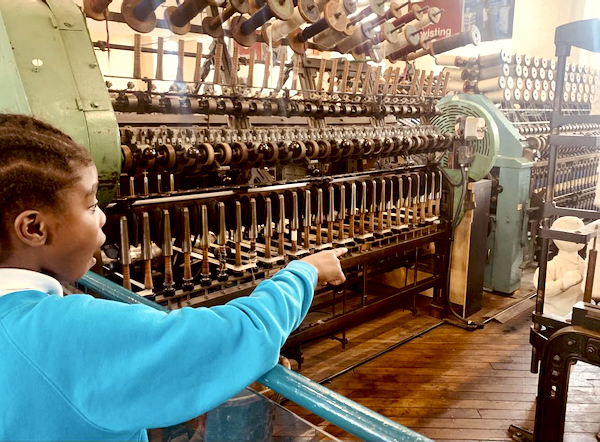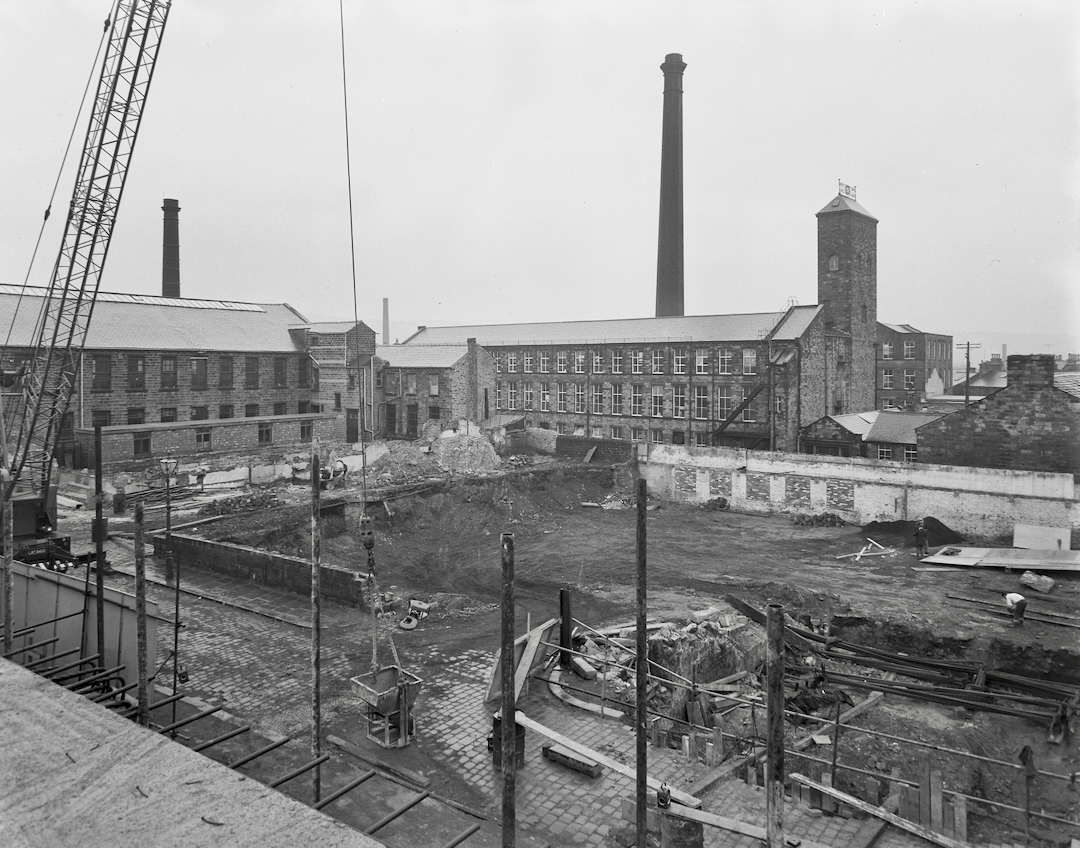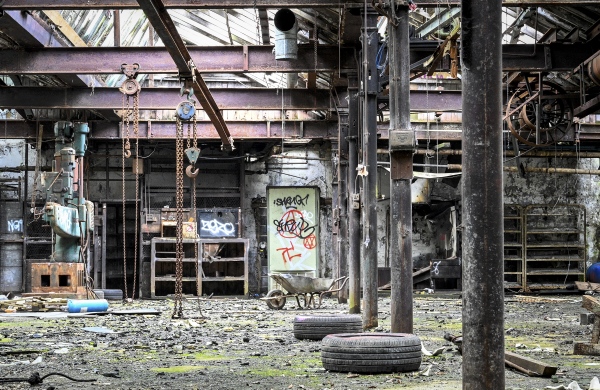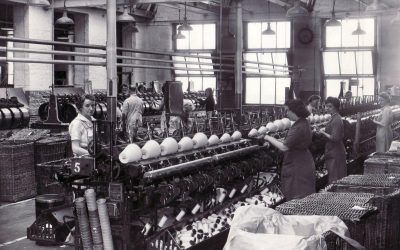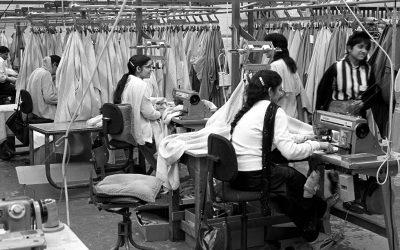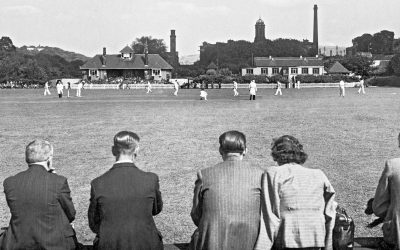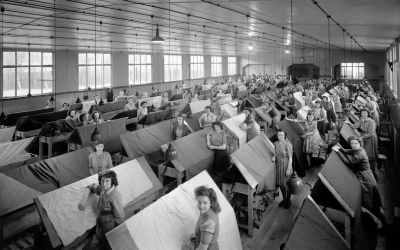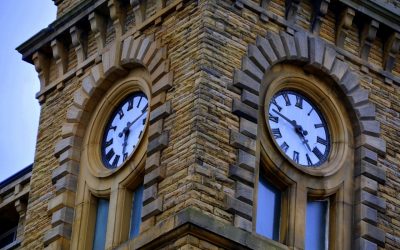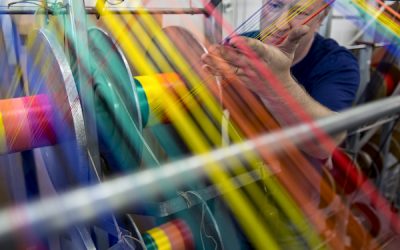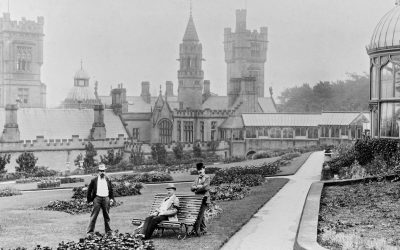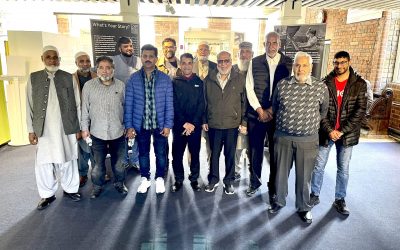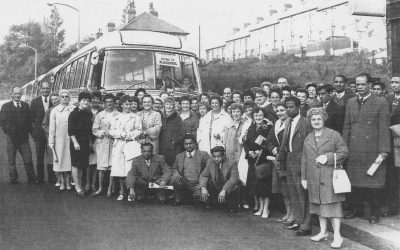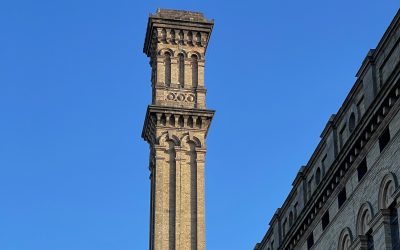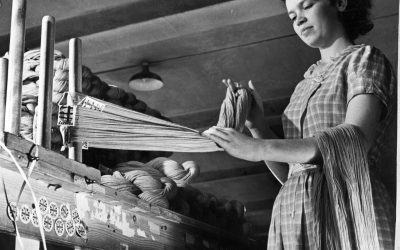I grew up next to Marriner’s and I actually watched it burn down. It would have been in the ‘70s. I was in my grandma’s house when the fire started ‘cos she lived round the corner. And I watched it burn down stood next to Dr Who off the telly at the time, which was Jon Pertwee. Because he’d been driving past, and he’d pulled in to see what was going on and he stood and watched it burn.
Bradford’s Remaining Textile Landscape
Rebecca Ough | Transcript
I’ve worked at a few different mills in Yorkshire, so I guess I have been part of like the textile landscape, I guess you could call it. Because it’s not… there’s still, there is still some some really high quality mills operating around here. I think maybe people assume that it’s in the past and it’s not really happening anymore. But you still have these really top quality, like world renowned mills. A.W. Hainsworth is a really good example. They weave Royal Guard fabric for the guards in London, transport fabrics for airplanes, protective fabrics for the fire brigade.
Local areas are constantly transforming due to different factors, including urban developments, geographical challenges, and political shifts. These changes shape the landscape and dynamics of our surroundings, impacting the way communities evolve and function. Learning about the history of our local areas, and memorable events that took place, improves our understanding of why our surroundings look the way they do today.
Exploring our local area offers a fascinating glimpse into history through various elements like infrastructure and street names. By observing the architecture of buildings, bridges, and roads, we can uncover clues about the historical periods they belong to. Street names often reflect the heritage, culture, and significant events of the past, providing insights into the area’s history (for example, the road names in Saltaire referencing members of the Salt family). Analysing these physical aspects allows us to connect with the stories of the past and appreciate how our local environment has evolved over time.
Many Bradford mills were referenced within the Lost Mills interviews, so a visual representation of these points was created to share the geographical distribution of textile mills within the project’s time period of the 1960s-present day. The Lost Mills and Ghost Mansions Map is available below via Google Maps and illustrates not only the placement, but also current conditions of all mill and mansion buildings through colour coding and symbols. This map is not exhaustive to all textile mills and associated buildings, however highlights mills with stories and photographs specifically shared by Lost Mills contributors, and shows the scale of Bradford’s textile empire.
Map Legend
Ghost Mansions: YellowRepurposed Mills: PurpleWorking Mills: GreenBurned Down Mills: OrangeDerelict Mills: Grey (with a skull and crossbones icon)Demolished Mills: Brown (with a hammer icon)Associated Industries: Spanner icon
Workforce’s Reaction to Drummonds Mill Closure in the 90s
Michael Stoney | Transcript
MS: Drummonds weren’t a good firm to work for. They were particularly ruthless with culling people, you know.
LMI: And this was in the ‘90s?
MS: Yeah, yeah. They were just run by accountants really. I mean when Drummonds came to the mill at Lindley… I mean that they had a guy in there for about six months, and they just took the, you know, everything was costed down to the last thread. They were just ruthless the way they treated people, I thought.
LMI: Did that make the workforce unhappy?
MS: Oh, yeah. Well, they knew the writing was on the wall. And there was a sense of unease because they knew people were in… and probably the history of Drummonds, you know, they’d closed down a lot of mills, and they knew it was coming, really.
In Yorkshire, the managers and supervisors treated Asian workers like third-class citizens, were incredibly rude to us and called us by shouting, ‘Oi!’. We were in need of work, so we put up with their abuse. In Lancashire the attitude towards Asian workers was better than in Yorkshire. In Yorkshire they held such hatred towards us and didn’t treat us as humans. The other thing about Yorkshire was that if you were under twenty-five, they made you do a full workload, but gave you half the salary. In Lancashire they didn’t, they gave you a full salary, so I moved to Lancashire.
Dalton Mill Burning Down
AMS | Transcript
I was quite sad because it’s such a gothic building. And it’s so much of Keighley’s history. And it was so horrendous. Because there were so many…I reckon it’ll be haunted. I reckon there’ll be…there’ll be quite a few souls in there. Because it was horrendous. If you imagine them working there, the kiddies used to work there, and it were hard.
Illingworth’s – out of the three jobs [I had] that was the best one. It was the cleanest out of the three, doing the same job. I had the run of the mill. I could go anywhere in it! I could go right in the deepest basements, right to the top attics, you know. I used to love it! I used to go and hide upstairs. And there was an old guy in the yarn store, a really old white guy, he said ‘Oh, you want a cup of tea, lad?’ He’d make me a cup of tea, and we’d sit there for ages just chin wagging, about nothing. And that was their work. I said, ‘I want your job, mate.’ He was just in charge of stores. He used to sit there drinking tea and coffee and I used to take carts to him, and he used to say, ‘Right, ok.’ And tick it off and put it in. That’s it.
Commuting Home with Hearing Loss from the Weaving Shed
Christopher Ackroyd | Transcript
Spinning mills weren’t as noisy as weaving. I worked in a weaving shed once for two weeks, in Silsden, after I’d left, but before I went to college. And they gave me a job there for two or three weeks, at Easter, I think. Just to make a bit of pocket money. And I was a battery filler in the weaving shed and I used to walk home from Silsden to Riddlesden. And I’d get to Riddlesden before I could hear properly. An hour afterwards, every day. Now I was only doing that for two or three weeks. And again, it’s mainly women who worked in those places. They were doing it forever. And it affected the way they speak to each other, sign language and all of that. The humour…
You would stop seeing a particular mill showing up in the book every morning and it’s like, ‘Oh no, they’re finished, they don’t work. They’re closed.’ As you drove around, you’d see more and more sites being demolished. At the time, and this is kind of the mid to late ‘90s, there wasn’t a lot of redevelopment. You could see stuff being pulled down, and the stone being carted away and possibly all the cast iron and so on. But I think they were not looking at it as a site to redevelop, they were just looking at it as salvage materials. Because these were all clad in stone with valley guttering with stonework on it as well. And so I think the fabric of the building itself was more valuable.
Things to do...

Cities are constantly changing to meet new needs of the people living and working there, and Bradford is a great example as it gains City of Culture status for 2025. Below are ways to change the way you see your local area, looking out for clues of its past:
What to do next...
Using our map as a guide, walk around your local area, paying particular attention to the architecture around you. How old are these buildings? What are they used for now, and were they designed for something completely different? Clues to look out for include decorative stonework, old lift shafts, and tall chimneys.
What to do next...
Find historical photographs of your local area and compare the streets, buildings, shops, cars, and fashions to the area today. What has stayed the same? What looks different? Bradford Museums & Galleries and local historical Facebook groups are great places to find older photographs!
Discover More
Lost Mills
Lost Mills & Ghost Mansions
Photograph: Tim Smith | UNSPUN How To Use The Learning Zone is a rich and fascinating resource for all. Take your time to explore and discover the many stories and insights on offer. Whether you are a student, a teacher, a researcher, a community group or an...
Working life
Photograph: Tim Smith | Lifting hanks of wool from a dyeing vat at Harrison Gardner and Company. If you've seen old mills, pictures of old mills and that, you'll see that there's a big mill with five or six storeys. And then at the back of it, probably, there's a one...
Diverse workforce
Photographs: Bradford Museums & GalleriesBackground: Bradford Museums & Galleries Photograph: Tim Smith | Combing at Haworth Scouring CompanyBackground: Bradford Museums & Galleries Photograph: Jaz Oldham | Jaz's Sister and Friend working in the mill The...
Time Off
Background: Bradford Museums & Galleries | Cricket Match in Saltaire Photograph: Jaz Oldham | Party in the MillBackground: Bradford Museums & Galleries | Cricket Match in Saltaire Photograph: Patricia Crabtree | Harold Heppleston, Patricia's Father, and...
Rights & Wrongs
Photograph: Val Rowland | Anwar Hussain (L), Bill Morris, former General Secretary of the Transport and General Workers Union (C), and Muhammad Rasab (R). Representing the racial discrimination case against John Haggas Ltd onstage at the Trade Union Annual Congress...
Changing Ways
Photographs: Mark Stevenson | Dalton Mill and Clock Tower I could see at that time that the mills were starting to close around Keighley all over the town and I thought ‘I need to be moving on somewhere’ and that's when I left in 1975 and joined the fire service....
Textiles Today
Background Photograph: Tim Smith | Laxtons' state-of-the-art spinning machinery in Baildon Title Photograph: Tim Smith | Weaving of Rainbow Ribbons at Wyedean Weaving in Haworth In 2022, I saw this job. And I rang them up and said ‘I’m looking for a job as a...
Ghost Mansions
I know that Robert Clough - he had a big mansion, and he donated a Christmas tree for the people of Keighley one year. Well, I won't be swayed on this at all. Particularly on a Friday night, when everybody else had gone home,...
Do It Yourself
Photograph: Alan Dix | Sangat Centre at Bradford Industrial Museum I think what people should do is show an interest in local history because one day (and I hope this never happens) there won’t be people like you, and there won’t be people like me, who...
Mediawall
Photograph: Margaret Dobson via Keighley and District Local History Society | Employees of John Haggas Ltd's Outing to Blackpool Lost Mills Media Wall Here we celebrate the rich visual history shared by contributors and project partners whilst researching Bradford's...
Archive
Photograph: Alan Dix | Lister's Mill ChimneyWelcome to the Lost Mills Archive. Here you will find all the recordings and transcripts that have been made during the lifetime of the project. It contains a wealth of information - far more than we could ever use in the...
Contributors
Thank you Lost Mills and Ghost Mansions has involved at least 500 people one way or another and their support, participation and commitment has taken us on a very special journey. Most of the people we interviewed were in their 70s and 80s and some were over 90. It is...
The contents of the 509 Arts website are protected by copyright unless otherwise stated. The Lost Mills Learning Zone recordings, text and activity suggestions are free to use for non-commercial community and education purposes. If you wish to use the materials for any other purpose, email info@509arts.co.uk with your plans.
Some of the images and video footage belong to a third party and are credited as such. If you wish to use any such content, please contact 509 Arts or the copyright owner directly.

